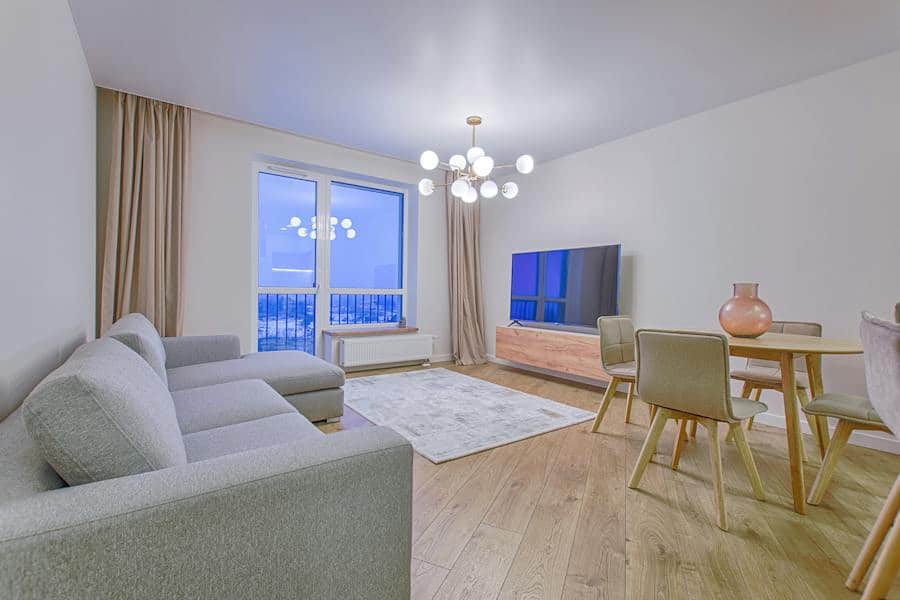Area rugs can add warmth, comfort, and style to any room, but there’s one common frustration that often comes with them – rug sliding. Whether it’s due to foot traffic, playful pets, or simply the natural inclination of rugs to shift over time, keeping area rugs in place can be a challenge. Fortunately, there are several practical solutions to prevent this annoyance and maintain the aesthetic and safety of your living space. In this comprehensive guide, we’ll explore various methods and tips on how to keep your area rugs from sliding, ensuring a secure and visually pleasing environment in your home.
How To Keep Area Rug From Sliding?
Preventing your area rug from sliding can be accomplished through various methods and techniques, each suited to different situations and preferences. Here’s a detailed explanation of several practical approaches:
Use Non-Slip Rug Pads: Non-slip rug pads are a foundational solution to prevent sliding. These pads, typically made of rubber, felt, or a combination, provide a grip between the rug and the floor. To use them effectively, choose a pad that matches the size of your rug, and make sure it’s slightly smaller than the rug to remain hidden. Simply place the pad under the rug, and the friction it provides will help keep the rug securely in place.
Double-Sided Carpet Tape: Double-sided carpet tape is a quick and effective fix. It works by adhering the rug to the floor, creating a solid bond. To use it, apply the tape to the underside of the rug’s corners and edges. Follow the manufacturer’s instructions for the specific tape you’re using. Remember that double-sided tape may not be suitable for all rug and flooring types, so check compatibility before use.
Rug Grippers And Corners: Rug grippers are specially designed products that anchor your rug to the floor. These grippers often have adhesive on one side to stick to the rug and a non-slip surface on the other to grip the floor. Place them in the corners or along the edges of your rug, and they’ll help prevent sliding and curling. Rug corners, similar to grippers, provide extra stability to the corners of your rug.
Velcro Or Hook-And-Loop Fasteners: Velcro strips or hook-and-loop fasteners are another option to secure your rug. Apply one side to the underside of the rug’s corners and the matching side to the floor. This solution is reusable and allows for easy repositioning of the rug when needed. Velcro works particularly well for smaller rugs or rugs that require frequent adjustments.
Weigh Down The Edges: Another practical method is to use the weight of furniture and decorative items to anchor the rug. Place heavy furniture, like sofas or coffee tables, on the rug’s edges. For smaller rugs, you can use decorative items like vases or bookshelves to keep them in place. This method not only prevents sliding but also adds a stylish touch to your space.
Regular Maintenance: To ensure long-term rug stability, practice regular maintenance. Vacuum your rug regularly to remove debris that may reduce friction. Check and readjust rug pads and grippers as needed, especially in high-traffic areas. Over time, inspect for wear and tear and address any issues promptly to maintain the rug’s integrity.
DIY Solutions: If you prefer a more budget-friendly approach, you can create your rug grippers using household items like silicone caulk, rubber shelf liners, or even pieces of an old rug. While these DIY solutions may offer a different level of effectiveness than commercial products, they can be a suitable temporary fix or a budget-friendly option for smaller rugs.
Importance Of Securing Area Rugs
Securing area rugs is paramount for several reasons, encompassing safety, aesthetics, and functionality. Here are some compelling reasons highlighting the significance of securing area rugs:
A sliding or bunching rug can be a significant tripping hazard, particularly in high-traffic areas or homes with young children, the elderly, or individuals with mobility issues. Securing area rugs reduces the risk of accidents, preventing potential injuries. Secured rugs provide a stable surface to walk on. This is especially important in homes with smooth flooring surfaces like hardwood or tile, where a sliding rug can result in slips and falls.
Area rugs protect the underlying flooring from wear, stains, and scratches. However, if the rug continuously shifts, it can inadvertently cause damage to both the rug and the floor. Securing the rug preserves the integrity of both.
An unsecured rug that frequently slides or bunches up can create a messy and unkempt appearance in a room. A securely anchored rug creates a well-organized, cohesive, and visually pleasing living space.
In open-plan living areas or rooms with multiple pieces of furniture, a moving rug can disrupt the intended furniture arrangement. Securing the rug helps maintain the desired layout and overall aesthetics of the space.
A secure rug enhances the overall comfort and functionality of a room. When a rug stays in place, it provides a consistent and comfortable surface for activities like sitting, standing, or playing.
An area rug that constantly shifts may experience more wear and tear. Securing the rug not only prolongs its lifespan but also ensures it retains its original beauty and functionality for longer.
Rugs can contribute to sound insulation, reducing echoes and noise levels. However, if a rug shifts, this sound-dampening effect may be compromised. A secure rug continues to serve its acoustic function effectively.
The Common Problem Of Area Rugs Sliding
One of the most common and frustrating issues associated with area rugs is their tendency to slide across the floor. This problem arises due to several factors:
- Area rugs are frequently placed on smooth and slippery surfaces, such as hardwood, tile, laminate, or vinyl. These surfaces provide minimal friction, making it challenging for rugs to stay in place naturally.
- In high-traffic areas like hallways, living rooms, and entryways, the constant movement of people can gradually shift and displace area rugs. Each step on the rug contributes to its slow but persistent migration across the floor.
- Many households have furry friends that add to the problem. Pets, especially dogs and cats, love to run and play on rugs. Their antics not only shift the rug but can also create dangerous tripping hazards.
- Everyday activities like moving chairs, tables, or other furniture items can displace area rugs. When furniture is slid across the rug or repositioned, it often drags the rug, causing it to bunch up or move out of place.
- Often overlooked, the need for proper rug padding or underlay is a significant contributing factor to rug sliding. Without a non-slip foundation beneath the rug, it lacks the necessary grip to stay firmly in place.
- Smaller or lighter rugs, especially those not appropriately anchored by furniture, are more susceptible to sliding. The weight and size of the rug play a pivotal role in its stability.
- Environmental conditions, such as fluctuations in humidity and temperature, can also impact the grip between the rug and the floor. Changes in humidity can cause rugs to expand or contract, affecting their position on the floor.
DIY Solutions For Preventing Rug Slippage
If you’re looking for budget-friendly and creative DIY solutions to prevent rug slippage, there are several options you can explore. While these methods may not be as foolproof as commercial products, they can be effective for smaller rugs or temporary fixes. Here are some DIY solutions for preventing rug slippage:
Non-Slip Rug Underlay From Household Items:
You can create your non-slip rug underlay using items you likely have at home. One option is to use a silicone caulking gun to apply lines or dots of silicone caulk on the back of the rug. Allow it to dry completely before placing the rug on the floor. The silicone will provide grip and prevent slippage.
Rubber Shelf Liner:
Rubber shelf liner, used to keep items from sliding in drawers or cabinets, can be a practical DIY rug gripper. Cut the liner into strips or pieces and place them under the rug, ideally around the edges and corners. The rubber texture provides traction against the floor.
Carpet Tape Alternatives:
Instead of commercial double-sided carpet tape, you can use alternatives like duct tape or masking tape. Create an “X” pattern with the tape on the rug’s underside and press it firmly against the floor. Keep in mind that tape residue may require cleaning later.
Rug Velcro:
You can use hook-and-loop fasteners like Velcro as a DIY solution. Attach one side of the Velcro to the rug’s corners and the matching side to the floor. This allows for easy repositioning of the rug while preventing slippage.
Homemade Rug Grippers:
Create your rug grippers by cutting pieces of a rubber bathmat or an old rug into smaller squares or strips. These can be strategically placed under the corners or edges of your rug to provide additional grip.
Adhesive Caulk Dots:
Adhesive caulk dots or circles, similar to what’s used for crafting, can be applied to the back of the rug at intervals. Allow them to dry thoroughly before placing the rug on the floor. These dots will act as small grippers to prevent sliding.
Carpet Foam Underlay:
If you have leftover carpet foam underlay from a previous installation or a carpet sample, you can cut it to fit the size of your rug. Place the foam underlay under the rug to create a non-slip layer.
Double-Sided Tape With Fabric:
Combine double-sided carpet tape with a strip of fabric or an old scarf. Apply the tape to the fabric and then attach the fabric to the rug’s underside. This method offers additional protection for delicate rugs.
Warping Up
Addressing the common problem of area rug slippage is essential for both the safety and aesthetics of your living space. Whether you opt for commercial solutions like non-slip rug pads, double-sided carpet tape, or rug grippers, or you prefer to explore creative and budget-friendly DIY alternatives, securing your area rugs offers numerous benefits. It prevents tripping hazards, preserves your flooring, enhances the overall look of your room, and contributes to a more comfortable and functional living environment. Before choosing a method to prevent rug slippage, consider the size and type of your rug, the flooring surface, and the specific needs of your space. Regardless of your choice, securing your area rugs not only ensures their longevity but also provides peace of mind, allowing you to enjoy your home with confidence.
FAQ’s
Q: Why Do Area Rugs Slide On Hardwood Floors Or Smooth Surfaces?
A: Area rugs slide on smooth surfaces because there is minimal friction between the rug and the floor. This can be exacerbated by foot traffic, furniture movement, and the rug’s size and weight.
Q: What Is The Best Way To Prevent An Area Rug From Slipping On Hardwood Floors?
A: One of the most effective ways to prevent rug slippage on hardwood floors is using non-slip rug pads specifically designed for this purpose. These pads provide grip and stability.
Q: How Often Should I Replace A Rug Pad?
A: The lifespan of a rug pad depends on its quality and usage. High-quality rug pads can last for several years, but it’s a good idea to inspect and replace them if they become worn, damaged, or no longer effective.





















